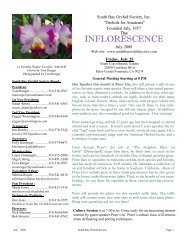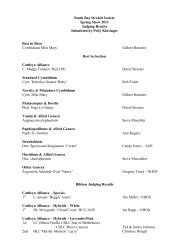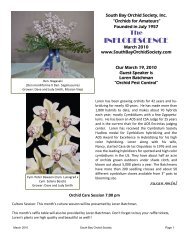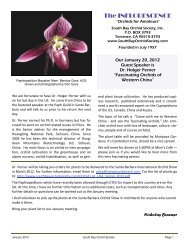May 2007 - South Bay Orchid Society
May 2007 - South Bay Orchid Society
May 2007 - South Bay Orchid Society
You also want an ePaper? Increase the reach of your titles
YUMPU automatically turns print PDFs into web optimized ePapers that Google loves.
<strong>South</strong> <strong>Bay</strong> <strong>Orchid</strong> <strong>Society</strong>, Inc.<br />
“<strong>Orchid</strong>s for Amateurs”<br />
Founded July, 1957<br />
The<br />
INFLORESCENCE<br />
<strong>May</strong>, <strong>2007</strong><br />
Web site: www.southbayorchidsociety.com<br />
Phalaenopsis George Vasquez<br />
<strong>South</strong> <strong>Bay</strong> <strong>Orchid</strong> <strong>Society</strong> Board:<br />
President:<br />
Ned Patton—-————-310-944-9798<br />
Email:———–epatton1@earthlink.net<br />
1st Vice President:<br />
Nick Braemer————-310-560-4384<br />
Email:——––-orchidnick@yahoo.com<br />
2nd Vice President:<br />
Ron Henry —————310-374-9699<br />
Email:—–-—–-orkidguy@earthlink.net<br />
Treasurer:<br />
Jim Rowley—–—–-——310-376-3542<br />
Email:——–jrowley1961@yahoo.com<br />
(Please note this is a new email address)<br />
Secretary:<br />
Polly Kinsinger————-310-374-6471<br />
Membership:<br />
Susann Patton—————310-944-9798<br />
Email:———-—slpatton@earthlink.net<br />
Newsletter Editor:<br />
Ned Patton————–-—310-944-9798<br />
Email——–-–—epatton1@earthlink.net<br />
Past President :<br />
Marla Corey———–——310-833-1918<br />
Email:———marlacorey@sbcglobal.net<br />
Webmaster/Publicity:<br />
Don Goss——————-310-316-3595<br />
Email:———webmstr@1stinmedia.com<br />
Show Committee Chairs:<br />
Marc Massari—-——-310-220-3507<br />
Email———-marc@streamsintl.com<br />
Marla Corey————310-833-1918<br />
Email-—-marlacorey@sbcglobla.net<br />
Saturday <strong>May</strong> 19, <strong>2007</strong><br />
11:00 AM-2PM<br />
ZUMA CANYON ORCHIDS<br />
5949 Bonsall Dr., Malibu CA<br />
No speaker this month. We do however<br />
have a picnic to attend at Zuma Canyon<br />
<strong>Orchid</strong>s where there will be plenty of fajita<br />
meat– both chicken and beef with all the<br />
fixin's. Salads, beverages and chips will<br />
also be presented. Some of us bring our<br />
own wine, beer or whatever we enjoy with our grilled fajitas. There<br />
will be a salsa competition with George Vasquez—our host— who is<br />
also our official salsa judge. Last year Marla won, so the challenge is<br />
on to unseat her. She claimed being a Texan helped. After judging<br />
everybody got to taste all of the<br />
entries, of which there were almost<br />
a dozen. I loved all of them—some<br />
were hot and some were not. I look<br />
for ward to this years entries. We<br />
were also given tours of the greenhouses<br />
and many of us bought our<br />
fill of Phalaenopsis in many colors.<br />
George and his family have been<br />
developing and growing orchids,<br />
mostly Phalaenopsis for many<br />
years. The grounds there are really<br />
spectacular, although I heard they<br />
lost some of their avocado trees<br />
from our freeze this year. It may be a warm day during our picnic, but<br />
under the trees at the Zuma Canyon picnic area the weather is just<br />
fine. George will present a potting demonstration for us and this is a<br />
good time to query an expert grower (and an AOS Judge) up close and<br />
personal about growing problems we may be having at home. At the<br />
end we do an opportunity table with everybody getting an orchid free,<br />
usually in full bloom. In short there is fun to be had by all!! I encourage<br />
everybody to come, even if you are a newer member and feel like<br />
you don’t know anybody. What a great way to meet other members.<br />
If you need a ride give Ron or us a call and we will find you a seat.<br />
Ned and Susann<br />
<strong>May</strong> <strong>2007</strong> <strong>South</strong> <strong>Bay</strong> <strong>Orchid</strong> <strong>Society</strong> Page 1
President’s Message<br />
Well—we had an election, and the results are in this Newsletter. Marla is going to be our fearless<br />
leader again, and we have a great group of leaders for the <strong>Society</strong> to help Marla make the next couple of<br />
years be even better. My congratulations to all of the winners, you are all great friends to have.<br />
I have only two more of these to write—since I get a badge at the June Installation Banquet that says<br />
“Past President”. In ways I think I will miss this, and in other ways I’m sure I won’t. Like I have said a<br />
number of times, I think that we have made some progress, but I know that there is a lot more to be<br />
done. We have had our controversies, and have gotten past a number of our difficulties. And, like I<br />
have said a number of times, controversy is a healthy thing in a group like ours, as long as everyone has<br />
the interests of the <strong>Society</strong> in mind rather than their own. So, I think that for these last two messages in<br />
the Inflorescence, I want to talk a little about the current state of the <strong>Society</strong> and what I think our future<br />
ought to hold for us.<br />
First—the State of the <strong>Society</strong> is GOOD. Financially, we are slowly growing the very nice nest egg<br />
that has been built up over the years, and the upcoming Board is a group of fiscally responsible people<br />
who are strongly motivated to ensure that our nest egg keeps growing. In fact, our financial position and<br />
operation is the envy of most other <strong>Orchid</strong> Societies in the local area. You can’t have fun as a <strong>Society</strong> if<br />
you are constantly worrying about how you’re going to pay for what you do.<br />
And, we have over the past couple of years re-established our prime goals as a <strong>Society</strong>. We have<br />
had many discussions in Board meetings about who we are and how we were originally organized, and<br />
our decisions as a Board have been guided by the founding principles of SBOS—to further the enjoyment,<br />
cultivation, and education of the public about orchids. That’s why we have <strong>Orchid</strong>s 101 and 102<br />
at our shows. The shows aren’t all about making money for the <strong>Society</strong>, they are about spreading the<br />
Word to the general public. We have even talked about becoming a 501.c.3 organization—for those of<br />
you that understand what that is. If you don’t, please ask me and I will give you a very brief lesson.<br />
So, what about the future. Where are we headed? What do we do? Do we just keep going along the<br />
same road that we have gone along in the past? We have been very successful doing just that, and are<br />
the envy of most other <strong>Orchid</strong> Societies. Will that lead us really into the future? Has the nature of the<br />
orchid world changed enough that we also need to change? I have my ideas about where we need to go,<br />
and I really want yours. My fondest wish is to be a part of this <strong>Society</strong> until they plant me in the ground.<br />
Later, Ned<br />
NO CULTURE SESSION FOR THIS MONTH—since there is no meeting. But there<br />
will be plenty ofcultural information on Phalaenopsis at the Picnic <strong>May</strong> 19, <strong>2007</strong>.<br />
Thank you all for coming and voting at the last meeting. These are<br />
the final results.<br />
New Officers for the <strong>2007</strong>-2008 Year<br />
Please join us at the Banquet to usher in our newest leaders. Details are on the Refrigerator<br />
door( page 7) Our New Officers are:<br />
Marla Corey - President<br />
Susann Patton - 1st VP<br />
Ron Henry - 2nd VP<br />
Polly Kinsinger - Secretary<br />
Jim Rowley - Treasurer<br />
Olga Cutting - Membership<br />
Nick Braemer; Marc Massari and Tom Renger - Directors<br />
<strong>May</strong> <strong>2007</strong> <strong>South</strong> <strong>Bay</strong> <strong>Orchid</strong> <strong>Society</strong> Page 2
So you want to grow a Big Leaf <strong>Orchid</strong>?<br />
Susann Patton<br />
Phalaenopsis have enjoyed an<br />
1. Dorsal Sepal<br />
immense dominance in the<br />
2. Petals<br />
marketplace of orchid flowers<br />
3. Column<br />
for some time now. This<br />
4. Callus<br />
popularity is due to their wide<br />
range of colors, their low acquisition<br />
cost and their sim-<br />
6. Antennae<br />
5. Lateral Sepals<br />
plistic beauty in the presentation<br />
of their flowers. These<br />
8. Axil Node<br />
7. Inforesence<br />
flowers are seen everywhere<br />
from the most sophisticated<br />
environments to the everyday<br />
7<br />
discount supermarkets. Most commonly when I am asked ‘how to grow my<br />
orchid?’, I have to inquire what type of orchids it is. Even with people not<br />
knowing what they have, I can describe it to them and they can readily confirm<br />
that it is the plant they bought or were given and that they would<br />
8<br />
like to keep it in bloom or re-bloom it. Above is the basic layout of the flower. Like Cattleyas they are symmetrical<br />
from the center out. The plant has broad thick flat leaves, which grow from inside of the base of the<br />
last leaf, forming a kind of support area that I hesitate to call a stem because a stem has certain properties that<br />
this type of supportive growth does not. This type of growth is called monopodial growth. Monopodial means<br />
single foot; I guess when the guys who described the growth of these plants they weren't able to do so any better<br />
than I. They grow upward rather than along a horizontal rhizome like that seen with Cattleyas (but you<br />
don’t call that type of growth polypodial?). The inflorescence is produced from the area between the stem (?)<br />
and leaf called the axil, usually down near the bottom area of the plant (8).<br />
Under normal conditions the inflorescence will start in the fall, as slight temperature<br />
changes cause the initiation of flowering. Because they are easily manipulated by<br />
temperatures, growers can control the environments the plants are grown in, producing<br />
plants in flower any time during the year. This is something which only adds to<br />
their popularity.<br />
Now a word on the ‘different’ types of Phalaenopsis. The most commonly seen<br />
plants are the large white or pink flowers, just called ‘large flowered’ Phalaenopsis.<br />
The first phalaenopsis described was the Phalaenopsis aphrodite in 1704 followed<br />
by Phalaenopsis amabilis fifty years later. Phalaenopsis equestris was found in<br />
1843 and the first hybrid was described in 1853 and was Phal x intermediate. We<br />
have come a long way since then (note pictures on next page). Now all shades of<br />
pinks are available, as well as patterns and stripes; whites with red lips. I just this<br />
last month saw a pale orange with red lips. Rich and pale yellows are now common,<br />
even with stripes, spots or bars. There are what we call Harlequin types with<br />
irregular nearly black blotching over different colors. These were developed from a<br />
mutated form of Phal. Golden Poker. The color pattern varies from flower to flower<br />
creating unusual patterns, so they are indeed different.<br />
Most Phalaenopsis species come from an area which includes northern India, southern<br />
China and northern Australia. These species; of which there are about 80 and<br />
are mostly found on mossy trees in shady habitats with high humidity or steamy<br />
environments that don’t have much for seasons. Their leaves are their storage units,<br />
lacking the pseudo-bulbs found with Cattleya—though they are epiphytes, growing on trees, or on rocks. For<br />
culture purposes keep in mind that they need consistent moisture around their roots, along with heat and humidity.<br />
But, and here’s the but; some species are also found in seasonally dry or cooler areas.<br />
<strong>May</strong> <strong>2007</strong> <strong>South</strong> <strong>Bay</strong> <strong>Orchid</strong> <strong>Society</strong> Page 3
Phalaenopsis<br />
x intermedia<br />
( aphrodite x<br />
equestris )<br />
Phalaenopis aphrodite; amabilis and equestris<br />
This is why it is important to understand where your plant originated through its parentage. The above species<br />
are the basis for the large flowering modern hybrids and are the easiest to grow, requiring the same warm and<br />
humid growing environments as the original species. If you do it right you can get up to 20 five-inch flowers on<br />
an inflorescence (pure beauty to me). These large flowers have antennae (6) flowing from the bottom of their<br />
lips, which distinguishes them from another type of Phalaenopsis, what some call the novelty types. These are<br />
what I have seen referred to as the “sturdy-flowering type” and form the next group of Phalaenopsis. The flowers<br />
have a heavier substance, are smaller and star shaped and the lips don’t have antennae (6) at the end. The<br />
Phal. violacea<br />
(Malayan form)<br />
Phal. violacea<br />
(Borneo form)<br />
Phal. amboinensis<br />
Phal. violacea x Phal. amboinensis<br />
(Both violacea forms contribute to red flowers)<br />
inflorescence is shorter. When you look at the breeding line these plants have species like Phal violacea and<br />
Phal amboinensis among others in their parentage. That is where they get the waxy flower and shorter inflorescence.<br />
That is also where some get their wonderful fragrance. New breeding is moving toward larger flowers<br />
with increased flower count, while retaining the bright colors and smells.<br />
There are the multifloral Hybrids, the third group. These were actually developed in California by Herb<br />
Hager. He went down a different path with the same species that gave us the large flower species requiring<br />
warmth and humidity so these will grow nicely with the other groups discussed.<br />
It is with the miniatures that we see a change in culture needed. These come from species like Phalaenopsis<br />
lobbii and P. parishii, which are mixed with other small flowering Phalaenopsis. Some of these species come<br />
from cool or dry habitats and because of that need lower temperatures and humidity than the other phals we<br />
have discussed. Some are even semi-deciduous. Phal. Lobbii is a true miniature that is a twig epiphyte usually<br />
found on mossy branches overhanging water. It does like high humidity, and loses its leaves during dry periods,<br />
leaving only green roots. This plant likes a dry winter rest. Phal. Mini Mark has been the most successful hybrid<br />
from these species. It is quite floriferous and produces<br />
branching spikes. This multi floral is unusual in that its<br />
breeding accounts for less than one-tenth percent of all<br />
breading for multiflorals. Almost all multifloral have Phal.<br />
equestris in their backgrounds (pictured at top of the page),<br />
except this one. Phal. maculate is one of the smallest and<br />
Phalaenopsis lobbii and P. parishii<br />
Phalaenopsis<br />
Mini Mark<br />
hardest to grow. But the primary hybrid of Phal (maculate<br />
x parishii) and the addition of Philippines has made a very<br />
nice plant.<br />
I have to end this now, but I hope you can start to see beyond the large flowered Phals, and while the white<br />
ones are beautiful there is a lot more to Phalaenopsis (Phalaenopsi?) than just that. George Vasquez’ family has<br />
been very involved in some of this history of the sturdy flowering type. There are still areas to cover like what<br />
is a Doritaenopsis anyway? And why do the plants have names like ‘Brother’? Where can you get hold of<br />
some of these species? What is a semi-alba? You let me know if you want me to continue. Until<br />
then…..see you at the picnic!<br />
<strong>May</strong> <strong>2007</strong> <strong>South</strong> <strong>Bay</strong> <strong>Orchid</strong> <strong>Society</strong> Page 4
Ribbon Judging Results<br />
April Meeting<br />
Advanced Amateur – Judged by Polly Kinsinger and Chuck Spain<br />
Cattleya<br />
1 st Jewel Box ‘Dark Water’ Bobby Ignacio<br />
2 nd Unknown Don Goss<br />
3 rd Irene Holquin Vallie McCray<br />
Cymbidium<br />
1 st Cali Nights Geyserland Ted Johnson<br />
2 nd Street Tango ‘Windy Kobe’ Don Goss<br />
3 rd Joann Managa “Tamiko’ Jasmine Bashi<br />
Paphiopedilum<br />
1 st Lebaudyanum Sorry! – Missed the name.<br />
2 nd Unknown Susann Patton<br />
3 rd Newberry Sprite Thamina Haque<br />
Oncidium/Odontoglossum Alliance<br />
1 st Yuylestrekera Melissa Brianne ‘Shady Lady’ Don Goss<br />
2 nd Yuylestrekera Melissa Brianne ‘Shady Lady’ Sorry! – Missed the name.<br />
3 rd Oncidium puchellum Susann Patton<br />
Phaleanopsis<br />
1 st Phal. Salu Spot Thamina Haque<br />
2 nd Dtps. Taida Sala Ted Johnson<br />
3 rd Phal. Miki Watanabe Susann Patton<br />
Other<br />
1 st Masdevalia Copper Angel Ted Johnson<br />
2 nd Leptoites bicolor Ted Johnson<br />
3 rd Ascofinetia Cherry Blossom Polly Kinsinger<br />
Amateur – Judged by Polly Kinsinger<br />
Paphiopedilum/Phragmipedium<br />
1 st Paph. Alma Gavaert’Hagers’ Peggy Wormington<br />
x Quicksilver ‘Ghostly’<br />
2 nd Phrag. Pearcel ‘Cloud’ x St. Owen ‘Sweet Blush’ Peggy Wormington<br />
3 rd Phrag. Andean Fire ‘Michelle Lee’ Peggy Wormington<br />
x Sorcerers Apprentice<br />
Phaleanopsis<br />
1 st Unknown Susan Amini<br />
2 nd Unknown Sandy Hammersmark<br />
3 rd Phal. Butterfly x Phal. Hisinying Susan Amini<br />
Other<br />
1 st Miltonia UnknownPeggy Wormington<br />
2 nd Dendrobium Unknown- Ultra New Grower Maria Gutierrez<br />
3 rd Cymbidium Unknown- Sandy Hammersmark Great Job!!<br />
<strong>May</strong> <strong>2007</strong> <strong>South</strong> <strong>Bay</strong> <strong>Orchid</strong> <strong>Society</strong> Page 5
<strong>South</strong> <strong>Bay</strong> <strong>Orchid</strong> <strong>Society</strong>, Inc.<br />
Meets on the third Friday of each month<br />
Culture Session at 7:00 p.m.<br />
General Meeting at 8:00 p.m.<br />
<strong>South</strong> Coast Botanic Garden<br />
26300 Crenshaw Blvd.<br />
Palos Verdes Peninsula, CA<br />
People, Places and Things<br />
Next Board Meeting—<strong>May</strong> 23 , <strong>2007</strong><br />
The Board Meeting in January will be held at the<br />
Levy Center, Torrance Adult School<br />
The meeting will start at 7:00 PM.<br />
Welcome New Members<br />
Please warmly welcome our newest members.<br />
Remember it is up to us, as a society to make<br />
all new members feel welcome.<br />
Allen and Fran Ravine came to us through the<br />
spring show. They have been growing Cyms,<br />
Catts and Paphs on their patio. These guys are<br />
going to give the rest of us some real competition,<br />
so look out all us beginners!<br />
Phyllis and John Thielman came to us through<br />
the fall show. These folks are new to our area, so<br />
be sure to give them an extra welcome. They are<br />
both growers and are expanding into orchids, and<br />
they have come to the right place to learn.<br />
More New Members<br />
Josephine Balboa came to us through<br />
the spring show and is a friend of Bobby<br />
Ignacio. Currently she is growing cyms outdoors.<br />
A big thanks to Bobby for sharing the<br />
good news about SBOS.<br />
Phal. Kilby Cassviola 'Sweet<br />
Fragrance' Love this!!!!<br />
Now these are some bright<br />
colors-this is bright copper<br />
Phal. David Lim<br />
Phal. Talin Lion 'Hsing'<br />
AM/AOS<br />
Dtps. 'Red Coral'<br />
Photos from<br />
<strong>Orchid</strong>s.com Norman’s <strong>Orchid</strong>s<br />
The sunshine report<br />
Marilyn Hill -Please take a few minutes to<br />
let Marilyn know we are sending her wishes<br />
for a fast recovery. She fell and will be recooperating<br />
from a broken bone. We will<br />
miss her at the picnic greatly.<br />
Dr Bob Streeter Wasn’t it great to see up on<br />
his feet again at the meeting. Welcome back<br />
Dr Bob. Gloria looks much happier as well.<br />
“Talk to your<br />
plants……when its<br />
appropriate’’<br />
Ann McNeeley is still recovering from her operation,<br />
and is still moving slowly. Please feel<br />
free to give her a call and let her know we are<br />
thinking of her.<br />
<strong>May</strong> <strong>2007</strong> <strong>South</strong> <strong>Bay</strong> <strong>Orchid</strong> <strong>Society</strong> Page 6
The Refrigerator Door<br />
<strong>Orchid</strong> Show Calendar<br />
<strong>May</strong> 07—June 07<br />
SBOS Committee Chairs:<br />
Librarian:<br />
Mary Glass………………...310-320-8600<br />
Raffle Tickets:<br />
Ted and Betty Cornell……..310-327-2826<br />
Refreshments:<br />
Carolyn Gould……………...310-546-2133<br />
Shirley Marble………...……310-379-0855<br />
Ribbon Judging:<br />
Polly Kinsinger…………….310-374-6471<br />
Marc Massari ..….…..……..310-220-3507<br />
Property Manager:<br />
Ron Henry…………..…...…310-374-9699<br />
Meeting Set-up:<br />
David Okihara….……..…....310-324-3211<br />
AOS Liaison:<br />
Bob Streeter..….………..…..310-541-6692<br />
<strong>South</strong>land Representative:<br />
Marilyn Hill………...…..…..310-675-0604<br />
Sunshine:<br />
Kathy West………………….310-643-8740<br />
Web Site:<br />
Don Goss…………………....310-316-3595<br />
E-mail………….....webmstr@1stinmedia.com<br />
WE NEED HELP WITH OPEN POSTIONS:<br />
Set up—Come in at 6:30 and help David set up the<br />
room for our meeting.<br />
Break Down- Stay a few minutes to help put things<br />
away.<br />
Introduction of <strong>Society</strong> to newest members-<br />
After the main talk, but prior to the opportunity table<br />
raffle, show our newest members how we function.<br />
I know a lot of you already are helping out, but lets<br />
spread the wealth a little more, it will be greatly appreciated<br />
by all.<br />
Historian- Some body to take pictures at the meetings<br />
of our winners or their flowers.<br />
<strong>May</strong> 19th <strong>2007</strong><br />
SBOS Annual Spring Picnic<br />
Zuma Canyon <strong>Orchid</strong>s<br />
BBQ and picnic under a canapé of trees<br />
Homemade Salsa competition<br />
Buy plants right out of George's greenhouses<br />
Plant demonstration by George Vasquez<br />
Everybody goes home with a plant<br />
11AM to 2PM<br />
405N toward Santa Monica<br />
Exit 10W toward Santa Monica<br />
Rt on Pacific Coast Hwy (19mi)<br />
Rt on Bonsall Dr to <strong>Orchid</strong> Nursery<br />
June 9th <strong>2007</strong><br />
<strong>Orchid</strong> <strong>Society</strong> of <strong>South</strong>ern California<br />
Auction<br />
First Christian Chruch<br />
221 S. 6th Street Burbank, CA<br />
Contact: Krystine Chapawo<br />
818-845-0492<br />
June 16th <strong>2007</strong><br />
SBOS <strong>2007</strong> INSTALLATION FUN<br />
Ports ‘O Call Restaurant<br />
Again this year please join us at the Installation<br />
dinner in San Pedro. The cost this year<br />
is $30 per person. Please let Ron know by<br />
June 13th if you are coming so he can give a<br />
head count to the restaurant.<br />
Ports ‘O Call Restaurant<br />
At the Ports O'Call Village<br />
77 Berth, #2a<br />
San Pedro, CA 90731-4401<br />
Ron Henry 310-374-9699<br />
<strong>May</strong> <strong>2007</strong> <strong>South</strong> <strong>Bay</strong> <strong>Orchid</strong> <strong>Society</strong> Page 7
“The Inflorescence”<br />
<strong>South</strong> <strong>Bay</strong> <strong>Orchid</strong> <strong>Society</strong><br />
c/o Ned Patton<br />
21816 Barbara Street<br />
Torrance, CA 90503<br />
See y’all at the picnic <strong>May</strong> 19.<br />
I do know how to use a barbeque.<br />
Ned<br />
<strong>May</strong> <strong>2007</strong> <strong>South</strong> <strong>Bay</strong> <strong>Orchid</strong> <strong>Society</strong> Page 8






